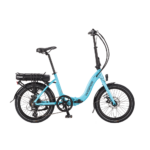C
Cyclezee
Guest
The Panasonic Drive System
A Panasonic Pedelec is a lot more than simply bolting a motor onto a great bike. Our electric-assist bicycles utilize a motor system that is lightweight, precisely-controlled, efficient, low-maintenance, and reliable. Here are the details of the drive system:
Centre Drive
The Panasonic drive system is centre drive, meaning that it's designed to be in the middle of the bike for a low centre of gravity, stability and an easy integration with the drivetrain. Note in the diagram below how the motor unit is a part of the normal arrangement of gears and chain on a bicycle and not a separate system. This setup also allows the motor to complement a full use of the gears on the bicycle. The power of the motor goes through the "transmission" of the bike before it reaches the wheel. A motor connected directly to the wheel would have to be more powerful, heavier, have reduced range, and lack the flexibility that gear selection offers.
Integrated Unit
The drive unit is more than just a motor; it also has a torque sensor and controller unit as well. You can't see them from the outside, but they're in the weatherproof casing, surrounding the motor. The torque sensor and the controller senses how hard you're pedaling and adjusts how much assistance the motor gives you through the drive sprocket.
Here is a photo of the drive system removed from the bicycle. The small toothed wheel is the drive sprocket and the large one is the chain wheel. Inside the sealed aluminum case is the motor, controller, and torque sensor, all in a package of less than 9 pounds (8.37)
Torque Sensor
Here's a cut-away diagram of the torque sensor as it would appear if looking through from the back of the bike. It can tell how hard you're pedaling by measuring torsion (twisting) through the spindle that connects the pedals to the drivetrain of the bike. It uses a textured indicator ring in the middle and a sensor coil that reads the ring electrically. It's highly sensitive and accurate, and does its job without mechanical contacts that would cause drag and make the bike harder to pedal.
The torque sensor sends information to the controller (a small computer) and they work together to deliver just the right amount of power through the motor.
The Motor
The drive unit uses a brushless DC motor "BLDC". This type of motor has tremendous advantages over a brushed DC motor including better reliability, more power, better efficiency, low maintenance, and all parts in a sealed enclosure. You can read a lot more about BLDC motors here: http://en.wikipedia.org/wiki/BLDC and see some diagrams that show how they operate.
Some important features and advantages of the BLDC motor over a brushed DC motor are:
A Panasonic Pedelec is a lot more than simply bolting a motor onto a great bike. Our electric-assist bicycles utilize a motor system that is lightweight, precisely-controlled, efficient, low-maintenance, and reliable. Here are the details of the drive system:
Centre Drive
The Panasonic drive system is centre drive, meaning that it's designed to be in the middle of the bike for a low centre of gravity, stability and an easy integration with the drivetrain. Note in the diagram below how the motor unit is a part of the normal arrangement of gears and chain on a bicycle and not a separate system. This setup also allows the motor to complement a full use of the gears on the bicycle. The power of the motor goes through the "transmission" of the bike before it reaches the wheel. A motor connected directly to the wheel would have to be more powerful, heavier, have reduced range, and lack the flexibility that gear selection offers.
Integrated Unit
The drive unit is more than just a motor; it also has a torque sensor and controller unit as well. You can't see them from the outside, but they're in the weatherproof casing, surrounding the motor. The torque sensor and the controller senses how hard you're pedaling and adjusts how much assistance the motor gives you through the drive sprocket.
Here is a photo of the drive system removed from the bicycle. The small toothed wheel is the drive sprocket and the large one is the chain wheel. Inside the sealed aluminum case is the motor, controller, and torque sensor, all in a package of less than 9 pounds (8.37)
Torque Sensor
Here's a cut-away diagram of the torque sensor as it would appear if looking through from the back of the bike. It can tell how hard you're pedaling by measuring torsion (twisting) through the spindle that connects the pedals to the drivetrain of the bike. It uses a textured indicator ring in the middle and a sensor coil that reads the ring electrically. It's highly sensitive and accurate, and does its job without mechanical contacts that would cause drag and make the bike harder to pedal.
The torque sensor sends information to the controller (a small computer) and they work together to deliver just the right amount of power through the motor.
The Motor
The drive unit uses a brushless DC motor "BLDC". This type of motor has tremendous advantages over a brushed DC motor including better reliability, more power, better efficiency, low maintenance, and all parts in a sealed enclosure. You can read a lot more about BLDC motors here: http://en.wikipedia.org/wiki/BLDC and see some diagrams that show how they operate.
Some important features and advantages of the BLDC motor over a brushed DC motor are:
- No electrical contacts. Brushes need to be maintained regularly, and as they wear down they leave debris inside the motor that can contaminate the contacts, making the motor less efficient or inoperable. Eventually they need to be replaced. The brushless motor works without contacts, which makes it low-maintenance and better at transferring power to move you forward.
- The magnets move, the motor coils don't. Most other electric motors have it the other way around. This means that the rotor can be lighter which makes it more responsive and efficient. The other advantage is that the driver coils of the motor stand still. They don't need to be reinforced to spin at high speed without problems and they can be cooled by conduction rather than airflow.
This is the end of the tour of what puts the assist into a Panasonic pedal-assist bicycle. It's a really clever arrangement of engineering and technology that you would hardly know is there if it weren't adding an extra push to your bicycle ride. Not only powerful, but so well constructed and reliable that you'll likely never have to pay any attention to it at all.
Not all my own work, mainly plagiarised
J hn
hn
Last edited by a moderator:












